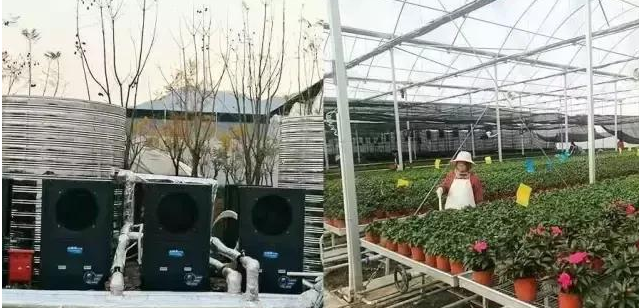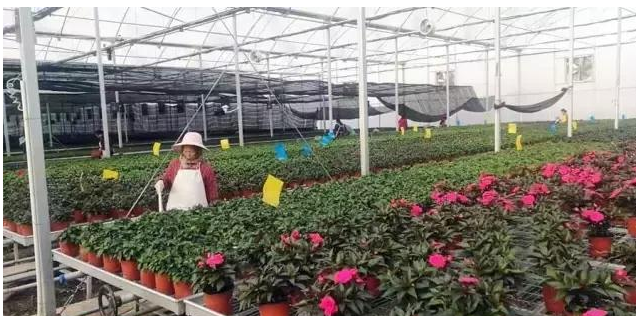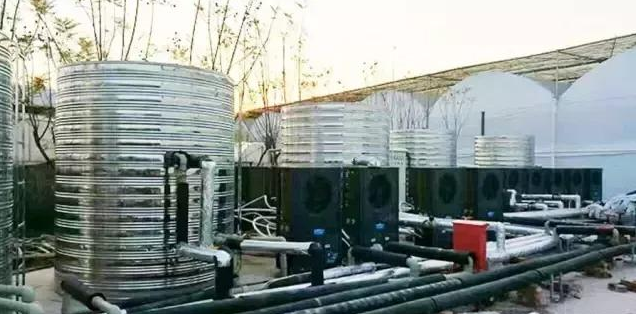In actual engineering, since the minimum temperature of the outdoor environment generally occurs in the latter half to the early morning, the heat supply requirement is the largest at this time, so the greenhouse design generally uses the heat supply at this moment as the heating design heat load. Because it is nighttime, the solar radiation heat, human body heat, lighting, and the heat generated by the equipment are neglected. No ventilation is required at night, and windows are not opened frequently, so the heat loss of ventilation and opening windows is negligible.
The thermal load calculation considerations for greenhouses under normal conditions include:
(1) Heat transmitted and radiated through the roof, floor, wall, doors and windows, etc., set to U1;
(2) heating the heat required to infiltrate the air through the gap between the door, the window and the enclosure structure, and set it as U2;
(3) The heat gain of the greenhouse under normal conditions is: the heat supply of the heating system, set to Q.
In this way, the heating load of the greenhouse heating design is simplified to:
Q=U1+U2
In the formula Q - greenhouse heating heat load, W; U1 - referred to as the heat loss of the enclosure structure, W; U2 - referred to as cold air infiltration heat loss, W; that is, greenhouse heating design heat load from the roof, the ground, the wall, the doors and windows The heat radiated from the enveloping structure and the heat radiated by the indoor air through the door, the window and the gap of the enclosure structure are composed of two parts.
I. Project Overview


If there is no specific planting plan, the heating interior design temperature should be designed for thermophilic crops. It is also a warm crop, and the minimum temperatures required for vegetables and flowers may vary. Typical thermophilic vegetables, such as cucumber and tomato, have a minimum growth temperature of 12 to 16 ° C, and some varieties may require 18 ° C. Generally, the indoor design temperature can be set to 15 ° C. Flower varieties have a wide range of temperature requirements, ranging from 10 to 22 ° C, generally considered to be 15 to 18 ° C; this program takes 16 ° C.
Third, the heat transfer calculation of the greenhouse greenhouse greenhouse structure
The amount of heat transfer through the greenhouse envelope includes both basic heat transfer and additional heat transfer. The basic heat transfer amount is the heat that is transmitted from the indoor to the outside through the temperature difference between the indoor and outdoor air through the surrounding structure of the greenhouse (roof, wall, etc.). The additional heat transfer amount is a correction of the basic heat transfer amount due to the difference in greenhouse structural materials, wind power, weather conditions, and the like.
(1) Basic heat transfer amount
The size of the flower greenhouse is: 50m long, 15M wide, 3M high, heat transfer calculation of the envelope structure
The basic heat transfer capacity of the basic heat transfer capacity is calculated according to the theory of stable heat transfer, that is, the basic heat transfer amount of the entire greenhouse is equal to the sum of the basic heat transfer amounts of its respective envelope structures. which is
Q1=∑qi=∑KiFi(Tn-Tw)=4.0W/(m2.K)×(50m×15m+50m×3m×2 faces+15m×3m×2 faces)×【16°C-(-12°C )]=127680W=127.7KW
Where: Q1 - the total heat transfer through all the envelope structures in the greenhouse, including the heat transfer capacity of the roof, wall, door, window and other external protective structures, W; Ki - greenhouse enclosure (roof, wall, Heat transfer coefficient of doors, windows, etc., W / (m2.K); Fi - heat transfer area of greenhouse enclosures (roof, wall, door, window, etc.), m2; Tn, Tw - respectively Indoor and outdoor heating design temperature of greenhouse, °C.
For a single material enclosure, the material's heat transfer coefficient K can be found directly from the relevant manual. The table below lists the heat transfer coefficients of commonly used light-transmissive cover materials for greenhouse enclosures. For special greenhouse light-transmissive covering materials, consult the manufacturer
(2) Additional heat transfer
The basic heat transfer capacity of the greenhouse enclosure calculated according to the stable heat transfer is not the total heat consumption of the greenhouse, because the heat consumption of the greenhouse is also related to its geographical location and its current status (such as height, orientation, wind speed). Etc.) These factors are complex and impossible to perform very detailed calculations. In engineering calculations, it is corrected based on the percentage of basic heat transfer based on years of accumulated experience. For greenhouse engineering, these additional amendments mainly include structural form corrections and wind corrections.
a. Structural form correction (α1) Greenhouse light-transmissive covering materials must have corresponding structural support. At present, the material of the support structure is mostly metal, mainly aluminum alloy. Compared with light-transmitting covering materials, (heat pump market watermarking) metal materials inlaid with these covering materials have high heat transfer speed and heat transfer amount, and the more aluminum alloy strips used for inlaying the covering material, the greater the additional heat transfer amount. In addition, gutters, ridges, window frames and skeletons of greenhouses are factors that increase the amount of heat transfer. In the engineering calculation, the above factors are uniformly considered, and the heat transfer amount of the structural form is used for correction.
b. Wind correction (α2) The wind has a great influence on the heat transfer capacity of the greenhouse. This is because the warming of the greenhouse enclosure structure and the outside world is mainly composed of the convective heat transfer and radiation of the outer surface of the enclosure structure and the ambient air. The convective heat transfer is related to the climatic wind speed. The outdoor wind speed directly affects the heat transfer coefficient of the outer surface of the envelope structure. (The heat pump market watermark) The wind speed is larger, and the surface heat transfer coefficient is larger, the heat transfer should be faster.
When calculating the basic heat transfer capacity of the enclosure, the selected external surface heat transfer coefficient corresponds to a certain fixed outdoor wind speed. In industrial and civil buildings, the heat transfer resistance of the envelope structure is much higher than that of the greenhouse. The influence of the external surface heat release coefficient on the heat dissipation of the entire envelope structure is small, and is generally not considered, but the greenhouse is covered by light. The thermal resistance of the material is generally small, and the change of the surface heat release coefficient has a great influence on the total heat dissipation. In the area where the wind force continues to increase during the heating period in winter, the wind influence factor must be considered in the heating calculation.

Generally, the wind additional correction coefficient is used to change the wind speed to consider the increase of the basic heat transfer amount of the greenhouse. The following table gives the range of values for the wind additional correction factor.
Table 5: Wind Additional Correction Factory is very professional
How to calculate the heat load of the greenhouse and the selection of the main engine when the heat pump greenhouse is heating?
(3) Cold air infiltration heat loss
In winter, outdoor cold air often enters the room through slits, door and window gaps, or door opening and window opening. The heat required to heat this part of the cold air from the outdoor temperature to the indoor temperature is called the cold air permeable heat loss.
Q2=Cpm(Tn-Tw)=CpNVγ/(Tn-Tw)=0.00028kw. h/(kg·°C)×1.25×(50m×15m×3m)×1.365×[16°C-(-12°C)]=30.1kw
Where: Q2 - greenhouse cold air infiltration heat loss, W; Cp - air specific pressure specific heat, Cp = 0.00082kW. h / (kg · ° C); m - the air quality of cold air infiltration into the greenhouse, kg; m = NV γN - the air exchange rate between the greenhouse and the outside world, also known as the number of air changes, in units of complete air changes per hour ; V - the internal volume of the greenhouse, m3; γ - the bulk density of the air, kg / m3.
The product of N and V in the above formula is the ventilation rate in m3/h. The number of air changes in greenhouses with different structures is shown in Table 6. The bulk density of air at the same temperature is shown in Table 7.
Table 6: Number of ventilations for different structural greenhouse designs
How to calculate the heat load of the greenhouse and the selection of the main engine when the heat pump greenhouse is heating?
Table 7: Bulk density of air at different temperatures
How to calculate the heat load of the greenhouse and the selection of the main engine when the heat pump greenhouse is heating?
(4) Ground heat transfer heat loss
The heat transfer on the greenhouse floor is very different from that of walls and roofs. The heat directly transmitted to the ground by indoor air cannot be calculated by Q=KAΔt, because the thickness of the soil cannot be calculated, and the temperature of the heat transfer position to the depth of the soil is also unknown. The heat transfer coefficient K of each layer of the soil is more difficult to determine.
Analysis of the heat transfer temperature field of greenhouse air to the soil shows that the greenhouse ground temperature is close to the indoor air temperature during heating, and the heat transfer from the middle of the greenhouse to the deep layer of the soil is small, and only the local heat transfer near the surface of the outdoor wall is large, and The closer to the outer wall, the greater the change in temperature field and the greater the amount of heat transfer. This part of the heat is mainly transmitted to the outside through the outdoor wall.
Since the above temperature field changes are complicated, it is very difficult to accurately calculate the heat transfer amount. To this end, a simplified calculation method, that is, a heat transfer coefficient method, is employed in the engineering.
Q3=∑KiFi(Tn-Tw)=0.47×(48m×13m)×[16°C—(—12°C)】=8211.8W=8.2KW
Where: Q3 - the total heat transfer through the greenhouse floor, W; Ki - the ground heat transfer coefficient of the i-th zone, W / (m2.K); Fi - the ground area of the i-th zone, m2; Tn, Tw - the temperature for indoor and outdoor heating in greenhouses, °C.
In view of the different effects of outside air temperature on the heat transfer on the ground, the ground heat transfer coefficient is also different. The ground near the outer wall has a short heat path and a small heat transfer coefficient, and the heat transfer coefficient is large. The heat transfer coefficient is small in the farther places. According to the experiment, in the ground within 6m from the outer wall, the heat transfer amount of the (heat pump market watermark) has a significant relationship with the distance from the outer wall, and the distance from 6m is almost independent of the distance. Therefore, in the engineering, the approximate calculation is generally adopted, and the section within 8 m from the outer wall is divided into a zone of 2 m width. Under the condition that the ground has no insulation layer, the heat transfer coefficient of each belt is shown in Table 8.
It should be noted that the heat flux of the 2m×2m area located within the first 2m of the corner is stronger and should be doubled. If the greenhouse is semi-subterranean, the wall below the outdoor floor will be used as the ground, and the sequence will be advanced.
Table 8: Ground segmentation and assumed heat transfer coefficient / [W / (m2. ° C)]
How to calculate the heat load of the greenhouse and the selection of the main engine when the heat pump greenhouse is heating?
Fourth, greenhouse heating heat load
The heating load of the greenhouse is calculated as follows:
Q=α1α2Ql+Q2+Q3=1.04×1.08×127.7KW+30.1kw+8.2KW=181.7kw
Where: Q - greenhouse heating heat load, W; α1 - structural additional coefficient; α2 - wind additional coefficient; Q1 - basic heat transfer capacity of the greenhouse, W; Q2 - greenhouse cold air infiltration heat load, W; Q3 - the amount of ground heat transfer in the greenhouse, W.
How to calculate the heat load of the greenhouse and the selection of the main engine when the heat pump greenhouse is heating?
Five, heat pump selection
With the heat load index, it can be selected according to the heating performance curve of the low temperature air source heat pump.
electric room heaters refrigeration &heating heat pump water heater shipping/Industrial Heat Pump Systems,Heat Pumps & Heating Systems/Air Source Heat Pump Supplier/China Heat Pump, Heat Pump Manufacturers/Air/water heat pump/Water/water heat pump
burner gas gas burner refrigeration &heating inverter pool Ground water source /Industrial Heat Pump Systems,Heat Pumps & Heating Systems/Air Source Heat Pump Supplier/China Heat Pump, Heat Pump Manufacturers/Air/water heat pump/Water/water heat pump
Daishiba heat pump refrigeration &heating shipping/Industrial Heat Pump Systems,Heat Pumps & Heating Systems/Air Source Heat Pump Supplier/China Heat Pump, Heat Pump Manufacturers/Air/water heat pump/Water/water heat pump- Ground Source Heat Pump,
heat pump water heater burner gas gas burner
Known for its 7 exceptional instant tempture inspection , stable heating and cooling,
Daishiba 's instant heating, refrigeration -25 degrees, strong water temperature up to 80 degrees, COP 4.6. Green life, low carbon and environmentally friendly earth, healthy and comfortable, Kida 's is available in over 100 countries and offers a full line of Professional Items, including .air source heat pump heating water,Cooling water,heating/cooling technology,water heater,heating&cooling heat pump solution.
Daishiba is a professional heat pump manufacturer based in China. With over decades of experience in the HVAC industry, Daishiba has become one of the leading brands of quality heating, cooling & hot water system. Our main products include heat pump, air conditioner & thermal equipments.
Daishiba Heating & Refrigeration Equipment Co. Ltd was founded in 2008 in China and well experience in energy-saving products. We have developed whole series of heating system equipments & energy-saving products with 5 series and more than 200 kinds of products in the past years. Our products range is as below:
Daishiba Heating & Refrigeration Equipment Co. Ltd
● Air to water heat pump.
● Water to water heat pump.
● Water to air heat pump.
● Commercial air conditioner.
● Fan coil units.
Besides Chinese market, export business is our main business. So most of our products are coming with international standard, some of our products have obtained international certificate, such as CE, RoHS, SAA certificate and ERP label etc, and our factory execute strictly. We are always insists on the principle of quality first, customer first, and focus on high-quality, competitive cost & fastest services. So far, our products have entered over 50 countries and regions with either brand name Daishiba or OEM brand.
ISO9001:2008
We are always on the look-out to build strategic partnerships in overseas markets and welcome opportunities where we can work in tandem with you and succeed together. OEM & ODM enquires are welcome.
Looking towards the future, Daishiba will build a fresh and quiet living environment and comfortable life for you.
DAISHIBA HEATING & REFRIGERATION EQUIPMENT CO. LTD
Address: Chuangye Nan Road, Songxia Industrial
Park Songgang Town Nanhai District Foshan Guangdong China (mainland)
Email: sussie@daishiba.com.cn
Website: www.daishiba.com.cn
air to air heat pump /water heat pump/geothermal heat pump /heat pump cost/geothermal heating and cooling / air heat pump heat pump compressor / hvac heat pump
Previous: how to choose air so...
Next: home heating boiler ...



